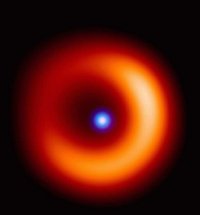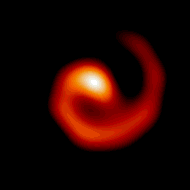Australian astrophysicist Dr Peter Tuthill of the University of Sydney says the technique, known as aperture masking interferometry, is opening new windows onto the life and death of stars.
Tuthill presents some of his recent work at the Astronomical Society of Australia meeting in Sydney this week.
This includes the first images of two mysterious spirals in the centre of the galaxy believed to be rare Wolf-Rayet stars.
Aperture masking was first used in the 1860s but it was abandoned during the 1920s because of the lack of electronics and computer technology.
Tuthill resurrected it while studying for his PhD and has since carried out a series of experiments using the technique at the WM Keck Observatory in Hawaii.
Getting clear astronomical pictures isn't simply a matter of building bigger telescopes, Tuthill says.
"When you turn the magnification up on a telescope you're not getting any more information, all you get is this fuzzy ball," he says.
"Because of this problem ... the ability to make sharp images or fine detail has remained unchanged for almost the whole of the 20th century.
"The technique I [am using has] been able to finally move that forward."
Masking essentially turns the modern telescope into a zoom lens, says Tuthill.
 |
A
young star eventually burns a cavity in the disk which fed it, in
effect severing its own umbilical cord and announcing its arrival as a
newborn star (Image: Dr Peter Tuthill) |
The mask is put over the mirror of the telescope, blocking off most of the light and only allowing a few beams of starlight through to the camera.
The holes function as an array of 'microtelescopes', which enhance the ability to recover an image.
Tuthill says the technique, which in theory can pick up the image of the head of a pin from 10 kilometres away, improves the ability of the Keck telescope to detect fine detail 20-fold.
It is also five times better at imaging bright objects than the Hubble Space Telescope, he says.
In 2001 Tuthill published images of LkH-alpha 101, a young star five times as massive as the Sun and about 522 light-years away.
The imaging technology allowed his team to see the inner structure of the doughnut shaped dust cloud surrounding the star and catch the first glimpse of its previously unknown companion star.
In the same year he obtained the first clear resolution of a dusty spiral surrounding the massive Wolf-Rayet 104 star, 800 light-years away.
Tuthill's most recent work, concentrating on the red giant IRC+10216 and a star-forming region known as W3RS5, was published recently in The Astrophysical Journal and Astronomy and Astrophysics.
Later this year Tuthill will return to Hawaii where he hopes to image some of the activity around black holes.
He will use a combination of masking and a technique known as adaptive imaging, which involves a mirror with a flexible surface.




